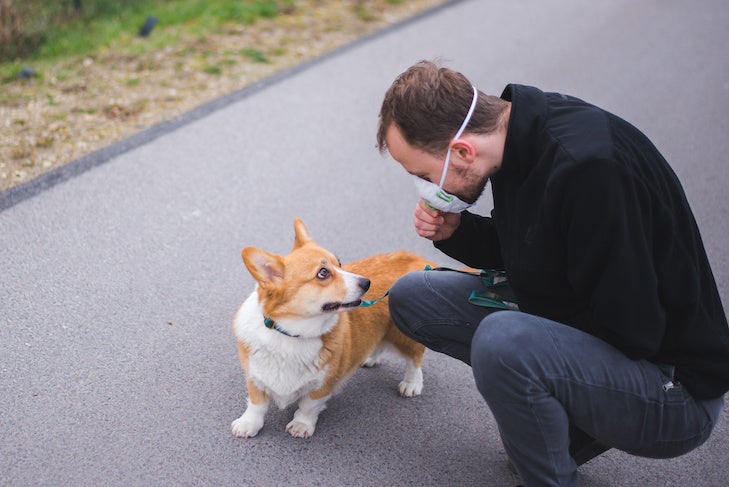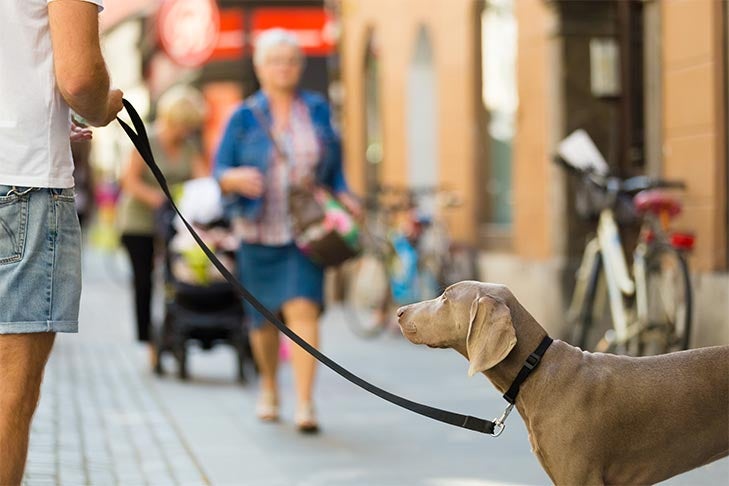
Training dogs, and especially the most challenging dogs, has taught me a lot about getting through life.
Figuring out how to take care of myself during, and after, the pandemic is no exception. I get my second COVID vaccine next week and, like many other people, this means I’m starting to cautiously think about what life will be like after the pandemic. The thought of returning to the world is both exciting and terrifying, so I’m trying to approach the situation using my dog-trainer brain.
As a profound introvert who already worked from home, I didn’t mind staying home for a year. I know a lot of people are completely excited and ready to return to “normal.” But I think many of us are also a little anxious and apprehensive of the world we will find—and what it will feel like to be part of it.
I’m a big believer that dogs can teach us so many things about ourselves. And as we think about what resocializing to the world might be like—and how we can make the experience less uncomfortable—we can learn a lot from dogs who have struggled with fear issues.
Positive Reinforcement
My dog-training philosophy is deeply rooted in positive reinforcement theories. For me, this means always trying to set dogs up for success using treats and toys so that they’re more likely to repeat that behavior in the future. It means using those rewards to not only help dogs complete specific tasks, but also to shape, or reshape, their understanding of the world.
The thing is, while most of us strive to be thoughtful and intentional when working with our dogs, we don’t always extend that same grace to ourselves. Like a lot of people, I can default to being pretty harsh with myself, especially if I’m feeling afraid or uncomfortable. I often force myself into a situation I find overwhelming, telling myself that I “should” be fine and minimizing any discomfort or fear I might have. But I would never treat a dog that way, so why would I dismiss my own feelings?
Life during the pandemic has been strange for all of us, and other than walking my dog and the occasional grocery store trip, I’ve barely left my home in the past year. The thought of returning to “normal” is exciting and also terrifying. But looking at reentering the world from a positive reinforcement model is helping me to think through where I’m going to go, and how I will intentionally approach those trips.
Do I need to go to the dentist for a cleaning? Yes, but I don’t plan for that to be the first thing I do. Instead, I’ve created a list of places that I’m looking forward to going once I’m fully vaccinated. At the top of this list is visiting pet supply shops with my dog for some public exposure and training opportunities for both of us. (Don’t forget that if you’ve been in lockdown, your dog likely has too, and they’ll need some training and support readjusting to the world.)
Find things that are exciting to you—maybe that’s entering or volunteering at a dog show again or signing up for a class with your dog. Or perhaps it’s seeing friends or family in person. In addition to all the necessary things you have to do, like home repairs or doctor appointments, make sure you build in personally rewarding outings. Think of them as self-training opportunities for yourself, like going to a favorite shop you’ve missed and giving yourself a budget to go on a mini shopping spree. Or grabbing ice cream or another treat while you’re out to reward yourself for a job well done.

Avoid Flooding
One of the biggest challenges that comes up for people working with fearful dogs is flooding them, either accidentally or out of a misguided idea that if you expose the dog enough to something, they’ll eventually get used to it. Flooding doesn’t help a dog become less fearful—it just overwhelms them. When “flooded,” a dog is so overstimulated by the stressor that they become unable to focus or learn. But while you may work hard not to flood your dogs while training them, you might not always be good at doing this for yourself.
If you haven’t gone anywhere besides an occasional trip to the grocery store in a year, it could be pretty overwhelming when you first start to go out. You might need to desensitize yourself to being around other people—especially if you’re not a natural extrovert. Instead of throwing yourself into a full day at an amusement park or a busy shopping mall, think of how you would train a dog. To avoid “flooding” yourself, plan shorter outings to less crowded places first. This will help you get acclimated to seeing lots of people and being out in public again, and you can then build on that success to get to a place where more crowded events feel possible.
Counter Conditioning
A fundamental approach to working with fearful dogs is counterconditioning, which allows us to slowly shift a dog’s emotional response to new, stressful, or scary situations. The key is to help the dog form positive associations without going “over threshold,” where they are over-stimulated or flooded with fear. I believe this same gentle approach is what all of us are going to need to think about as we prepare to reenter a world that feels like it could hurt us.
With counterconditioning, you aren’t forcing a dog to tolerate something they find uncomfortable, scary, or stressful. Instead, you work at a distance the dog is comfortable with, rewarding calm behavior at that distance. Very slowly and intentionally over time, you are able to move slightly closer and have the dog continue to exhibit the calm behavior, even in the presence of the previously stressful stimuli. I learned my best lessons about counterconditioning from my now passed rescue dog, Charlotte. She had lived on the streets before I adopted her and had a lot of fear issues and anxiety. Charlotte taught me important lessons about going at her pace and not comparing her progress to other dogs. I learned to meet her where she was and to celebrate the small successes.
So when the world feels overwhelming and panic-inducing, we need to be as gentle with ourselves as we would be with a scared dog. Go at the pace that feels comfortable to you. Maybe treat yourself to something from a favorite café and sit in the park and watch people at a distance before walking through a bustling farmers market. Getting through this pandemic has been hard and intense for all of us in different ways. And it isn’t over yet—for some of us, the work to get back to a sense of “normal” is only beginning. But I believe that the lessons we’ve learned from dog training can go a long way in helping us to work through the fear and get back to the places and activities we love.
The AKC is here to help owners with questions and concerns about COVID-19 and dogs. Find answers to your questions, plus at-home activity ideas, training tips, educational resources, and more on our Coping With COVID-19 hub.

